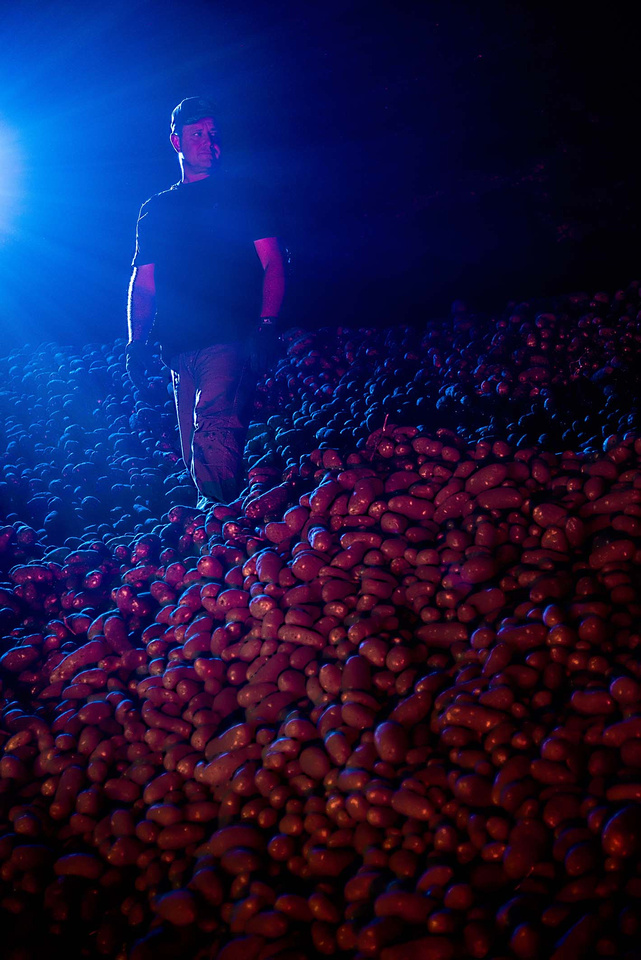Feeding the World
 That's a mound of potatoes Kevin's standing on. Go here for more details.
That's a mound of potatoes Kevin's standing on. Go here for more details.
Meet Kevin. He has a lot to do with the Thanksgiving meal most of us Americans will enjoy in two days. He's a Tulelake, California, farmer standing on the mashed potatoes we'll heap onto our plates next to the turkey. That's a two-story stack of potatoes – just one farm's output of one of its crops. You're seeing the tip of the tip of the tip of the iceberg.
According to the American Farm Bureau Federation, only about two percent of us in the US are farmers, but it takes 15 percent of us -- 21 million people -- to process, pack and ship what they turn out. Thanks to what they do, we only have to spend about 10 percent of our disposable income on food, yet incredibly, a third of America's agricultural output gets exported. Last year, the US exported more than 30 billion metric tons in wheat alone. We raise nearly half of the world's soybeans and corn. All-in-all, every America farmer feeds 140 to 155 people (sources vary on this estimate) around the world. Fifty years ago, it was about 26. Yes, we import a lot of food, too, but we export more than we bring in.
American farmers work long days (actually, they work long hours – their "days" often start and end in the dark), with an average estimated return of only about 12 to 16 cents on the dollar. That's about half the return they had 30 years ago, by the way, without adjusting for inflation. And, it takes a lot of dollars to farm today. Take for examples, which start, with the required attachments, at $100,000 but can cost twice that. American farmers produce more than ever before, and will likely have to do even more over the next 15 years as global populations rise. Even with growing demand and lower returns, though, our farmers are increasing their sustainability and green practices. Most farms conserve large wildlife areas, plant trees and other plants and increasingly implement sophisticated agricultural practices so that they need less water, fertilizer etc. per acre than a few decades ago. Farms are the main developers of alternative energies, and the primary users of some forms.
It's not an easy life, but thank God they do it.
Next time we sit down to dinner – especially at Thanksgiving – and say grace, perhaps we could add a word of blessing and thanks for Kevin, his family and all the other farm families who literally feed the rest of the world.
Comments
|
January
February
March
(4)
April (4)
(2)
May (2)
(2)
June (2)
(1)
July (1)
(2)
August (2)
(1)
September (1)
(1)
October (1)
(1)
November (1)
(1)
December (1)
|
(1)
January (1)
(1)
February (1)
(1)
March (1)
(1)
April (1)
(1)
May (1)
(1)
June (1)
(1)
July (1)
(1)
August (1)
(1)
September (1)
(1)
October (1)
November
(1)
December (1)
|
(1)
January (1)
February
(1)
March (1)
April
(1)
May (1)
June
(1)
July (1)
(1)
August (1)
(1)
September (1)
October
(1)
November (1)
(1)
December (1)
|
(1)
January (1)
(1)
February (1)
March
April
May
(1)
June (1)
July
August
September
(1)
October (1)
November
December
|
(1)
January (1)
(1)
February (1)
(1)
March (1)
April
May
June
(1)
July (1)
August
(1)
September (1)
October
November
(1)
December (1)
|
January
(1)
February (1)
March
April
May
June
(1)
July (1)
(1)
August (1)
September
October
(1)
November (1)
(1)
December (1)
|
January
February
March
April
May
June
(1)
July (1)
August
September
October
November
(1)
December (1)
|
January
February
March
April
May
June
July
August
September
October
November
December
|
January
February
March
April
May
June
July
August
September
(1)
October (1)
(1)
November (1)
December
|